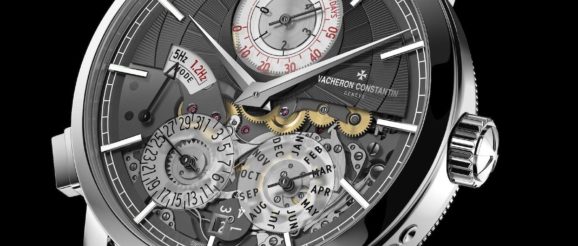GPHG “Innovation” Prize given to Vacheron Constantin Traditionnelle Twin Beat Perpetual Calendar | Time and Tide Watches

It’s been a very busy week of watches in Geneva, with Only Watch 2019 setting new records, and the Grand Prix d’Horlogerie de Genève (GPHG) awarding prizes to some of the best watches of the year (which included some upsets). Amidst the clamour and drama of the GPHG, where the pitting of brands head to head can increase the blood pressure of some ardent watch enthusiasts, the focus can sometimes miss the truly impressive feats of technical engineering that are on display. One of these feats is the Vacheron Constantin Traditionnelle Twin Beat Perpetual Calendar, a watch that not only offers a complex calendar function, but also does it with a power reserve of 65 days. Here’s how more than two months of power reserve is possible.
Most mechanical watches are regulated by a single balance spring that oscillates at a set rate (either measured in hertz, which can be converted to vibrations per hour), and the steady in and out breathing of this spring is what keeps the watch running on good time. A slower number of oscillations from the balance spring can make the watch less accurate, but can extend the power reserve, while a faster rate of movement improves accuracy but eats into the period between the watch needing a wind. Most watches today run at 4Hz (28,800vph), but in the 1960s a number of Swiss and Japanese watch manufacturers were searching for the limits of mechanical accuracy, and produced watches that ran at 5Hz (36,000vph, or the second hand moves 10 times per second).
The innovation offered by the Vacheron Constantin Traditionnelle Twin Beat Perpetual Calendar is that it features two different oscillators that run at different speeds, essentially giving the best of both worlds in accuracy and a long power reserve. One of the oscillators runs at 5Hz (36,000vph) for accurate time-telling while the watch is on your wrist (and gives you four days of power reserve), and the other ticks away at 1.2Hz (8640vph) when you switch the watch to “Standby Mode”, thus extending its minimum power reserve to at least 65 days.
This length of power reserve is particularly practical in a manual-wind perpetual calendar, as it is a little more complex to correctly reset the watch when it displays the hours, minutes, date, month, leap-year cycle and power reserve. The movement responsible for this genuinely impressive watchmaking achievement is the Calibre 3610 QP, developed by Vacheron Constanin themselves, and containing 480 components. It is contained in a platinum case that measures 42mm in diameter, but is only an amazing 12.3mm thick, making it a compact package considering its intricacy.
Despite the Traditionnelle Twin Beat Perpetual Calendar being one of the most outstanding technical watchmaking innovations of recent years, it is significantly more wearable, and therefore more approachable, than a number of other highly complicated watches from other manufacturers. Luckily, however, even if you don’t find it on your wrist every week, you can rest easy knowing you won’t have to spend an age resetting it because it’ll still be ticking.
